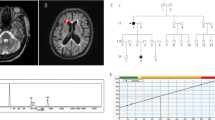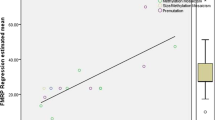Abstract
Premutations in the fragile X mental retardation 1 (FMR1) gene cause fragile X-associated tremor/ataxia syndrome (FXTAS) and FMR1-related primary ovarian insufficiency (POI). Female FMR1 premutation carriers rarely develop motor features. Dual pathology is an emerging phenomenon among FMR1 premutation carriers. Here, we describe a family affected by FMR1-related disorders in which the female index case has developed a rapidly progressive and disabling syndrome of atypical parkinsonism. This syndrome consists of early onset postural instability, echolalia, dystonia, and varying types of apraxia like early onset orobuccal apraxia and oculomotor apraxia. She has also developed supranuclear gaze palsy, increased latency of saccade initiation, and slow saccades. These features are compatible with progressive supranuclear palsy (PSP) of a corticobasal syndrome (CBS) variant. Imaging displays a marked reduction of presynaptic dopaminergic uptake and cerebrospinal fluid analysis showed reduced dopamine metabolism; however, the patient is unresponsive to levodopa. Midbrain atrophy (“hummingbird sign”) and mild cerebellar atrophy were found on brain MRI. Her father was affected by a typical FXTAS presentation but also displayed dopamine deficiency along with the hummingbird sign. The mechanisms by which FMR1 premutations predispose to atypical parkinsonism and dopamine deficiency await further elucidation.



Similar content being viewed by others
Abbreviations
- CBS:
-
Corticobasal syndrome
- CSF:
-
Cerebrospinal fluid
- DAT:
-
Dopamine transporter
- DOPAC:
-
3,4-Dihydroxyphenylacetic acid
- FMR1 :
-
Fragile X mental retardation 1
- FXTAS:
-
Fragile X-associated tremor/ataxia syndrome
- 5-HIAA:
-
5-Hydroxyindoleacetic acid
- HVA:
-
Homovanillic acid
- MCP:
-
Middle cerebellar peduncles
- POI:
-
Primary ovarian insufficiency
- PSP:
-
Progressive supranuclear palsy
References
Hagerman RJ, Leehey M, Heinrichs W, Tassone F, Wilson R, Hills J, et al. Intention tremor, parkinsonism, and generalized brain atrophy in male carriers of fragile X. Neurology. 2001;57:127–30.
Jacquemont S, Hagerman RJ, Leehey M, Grigsby J, Zhang L, Brunberg JA, et al. Fragile X permutation tremor/ataxia syndrome: molecular, clinical, and neuroimaging correlates. Am J Hum Genet. 2003;72:869–78.
Apartis E, Blancher A, Meissner WG, Guyant-Maréchal L, Maltête D, De Broucker T, et al. FXTAS: new insights and the need for revised diagnostic criteria. Neurology. 2012;79:1898–907.
Hagerman R, Hagerman P. Advances in clinical and molecular understanding of the FMR1 premutation and fragile X-associated tremor/ataxia syndrome. Lancet Neurol. 2013;12:786–98.
Brunberg JA, Jacquemont S, Hagerman RJ, Berry-Kravis EM, Grigsby J, Leehey MA, et al. Fragile X premutation carriers: characteristic MR imaging findings of adult male patients with progressive cerebellar and cognitive dysfunction. Am J Neuroradiol. 2002;23:1757–66.
Loesch DZ, Litewka L, Brotchie P, Huggins RM, Tassone F, Cook M. Magnetic resonance imaging study in older fragile X premutation male carriers. Ann Neurol. 2005;58:326–30.
Cohen S, Masyn K, Adams J, Hessl D, Rivera S, Tassone F, et al. Molecular and imaging correlates of the fragile X-associated tremor/ataxia syndrome. Neurology. 2006;67:1426–31.
Tassone F, Greco CM, Hunsaker MR, Seritan AL, Berman RF, Gane LW, et al. Neuropathological, clinical and molecular pathology in female fragile X premutation carriers with and without FXTAS. Genes Brain Behav. 2012;11(5):577–85.
De Pablo-Fernandez E, Doherty KM, Holton JL, Revesz T, Djamshidian A, Limousin P, et al. Concomitant fragile X-associated tremor ataxia syndrome and Parkinson’s disease: a clinicopathological report of two cases. J Neurol Neurosurg Psychiatry. 2015;86(8):934–6.
Fraint A, Vittal P, Szewka A, Bernard B, Berry-Kravis E, Hall DA. New observations in the fragile X-associated tremor/ataxia syndrome (FXTAS) phenotype. Front Genet. 2014;5:365–9.
Levin J, Kurz A, Arzberger T, Giese A, Höglinger GU. The differential diagnosis and treatment of atypical parkinsonism. Dtsch Arztebl Int. 2016;113:61–9.
Massey LA, Micallef C, Paviour DC, O'Sullivan SS, Ling H, Williams DR, et al. Conventional magnetic resonance imaging in confirmed progressive supranuclear palsy and multiple system atrophy. Mov Disord. 2012;27:1754–62.
Adams JS, Adams PE, Nguyen D, et al. Volumetric brain changes in females with fragile X-associated tremor/ataxia syndrome (FXTAS). Neurology. 2007;69:851–9.
Acknowledgments
Financial support for this study was obtained from the CBD solutions AB and Stockholm City Council. We thank Dr Vesna Jelic for referring the index case to us.
Author information
Authors and Affiliations
Corresponding author
Ethics declarations
All participants have given oral and written consent for this work. The study has been approved by the local ethical committee (2011/500-31/1).
Conflict of Interest
The authors declare that they have no conflicts of interest.
Electronic Supplementary Material
Below is the link to the electronic supplementary material.
Video 1
Episodic echolalia of the index case (II:2) when examined at 46 years of age. (MP4 1161 kb)
Video 2
Eye movement disorder of the index case (II:2) when examined at 46 years of age. (MP4 3060 kb)
Video 3
Unsteadiness and balance problems of the index case (II:2) when examined at 46 years of age. (MP4 1794 kb)
Video 4
Unsteadiness and falls of the index case (II:2) when examined at 49 years of age. (MP4 1658 kb)
Video 5
Severe speech problem and severe eye movement disorder of the index case (II:2) when examined at 49 years of age. (MP4 3596 kb)
Video 6
Tremor of the father (I:1) of the index case. (MP4 1785 kb)
Video 7
Unsteadiness and balance problems of the father (I:1) of the index case. (MP4 2666 kb)
Video 8
Lack of vertical supranuclear gaze palsy of the father (I:1) of the index case. (MP4 1672 kb)
Video 9
Action tremor of the sister (II:1) of the index case. (MP4 3329 kb)
Rights and permissions
About this article
Cite this article
Paucar, M., Beniaminov, S., Paslawski, W. et al. PSP-CBS with Dopamine Deficiency in a Female with a FMR1 Premutation. Cerebellum 15, 636–640 (2016). https://doi.org/10.1007/s12311-016-0793-x
Published:
Issue Date:
DOI: https://doi.org/10.1007/s12311-016-0793-x




